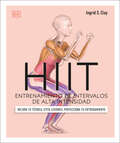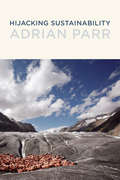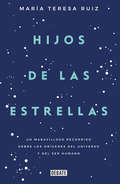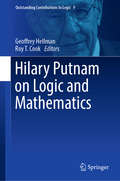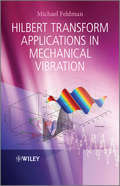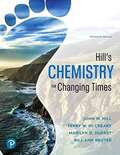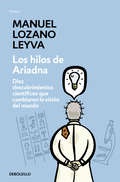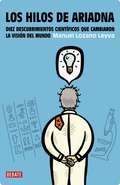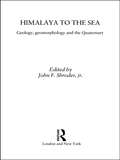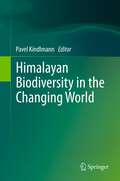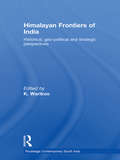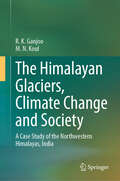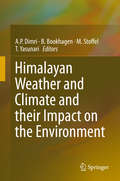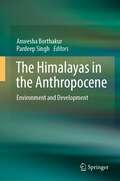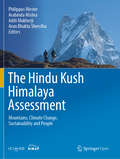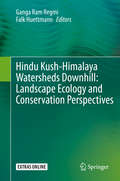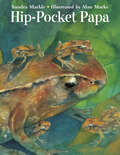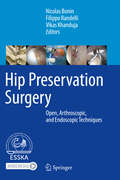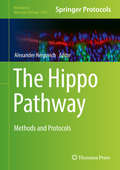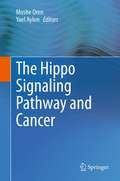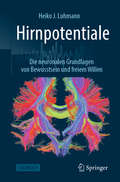- Table View
- List View
HIIT: Entrenamiento de intervalos de alta intensidad (DK Science of)
by Ingrid S. Clay- Más de 90 ejercicios esenciales de HIIT, para dominar cada movimiento con confianza y control. - Técnicas de tonificación corporal específicas. - Los mejores planes de entrenamiento HIIT para que pierdas peso.Este libro explica los beneficios de incorporar este entrenamiento a tu rutina de ejercicios. Mejora tu técnica y pon en práctica un programa flexible de ejercicios para fortalecer tu cuerpo y mente.------------------------------------------------------------------------------------- More than 90 HIIT resistance exercises. - Easy-to-follow infographics help explain the hard science behind why HIIT training is so efficient, and what beneficial physical adaptations it can bringHigh-intensity interval training is a fantastic way to lose weight and get strong by performing very short bursts of targeted exercise. The clear CGI artwork details the mechanics of each exercise, correct body posture, the muscles involved and how they engage to perform movements. This HIIT guide will completely transform your performance and help you smash your goals!
Hijacking Sustainability
by Adrian ParrHow the sustainability movement has been co-opted: from ecobranding by Wal-Mart to the “greening” of the American military.The idea of “sustainability” has gone mainstream. Thanks to Prius-driving movie stars, it's even hip. What began as a grassroots movement to promote responsible development has become a bullet point in corporate ecobranding strategies. In Hijacking Sustainability, Adrian Parr describes how this has happened: how the goals of an environmental movement came to be mediated by corporate interests, government, and the military. Parr argues that the more popular sustainable development becomes, the more commodified it becomes; the more mainstream culture embraces the sustainability movement's concern over global warming and poverty, the more “sustainability culture” advances the profit-maximizing values of corporate capitalism. And the more issues of sustainability are aligned with those of national security, the more military values are conflated with the goals of sustainable development.Parr looks closely at five examples of the hijacking of sustainability: corporate image-greening; Hollywood activism; gated communities; the greening of the White House; and the incongruous efforts to achieve a “sustainable” army. Parr then examines key challenges to sustainability—waste disposal, disaster relief and environmental refugees, slum development, and poverty.Sustainability, Parr says, offers an alternative narrative of the collective good—an idea now compromised and endangered by corporate, military, and government interests.
Hijos de las estrellas
by Maria Teresa RuizEdición revisada, aumentada y con nuevas imágenes En Hijos de las estrellas, la reconocida astrónoma María Teresa Ruiz condensa generosamente el conocimiento que existe sobre el universo, explicando en qué parte de este estamos así como cuándo y cómo llegamos aquí. Al mismo tiempo, describe con precisión y amenidad los métodos, técnicas e instrumentos con que se han llevado a cabo las investigaciones que han permitido llegar a las principales definiciones y teorías astronómicas. Y todo esto lo hace con un lenguaje claro y atractivo que en ningún caso descuida la complejidad de la información. Su premisa, formulada ya en las primeras líneas de este libro asombroso, es que la curiosidad y el espíritu explorador son los factores que propician la evolución de la humanidad, pues esta accede al conocimiento «del mismo modo en que un niño pequeño explora el mundo que lo rodea tirando objetos al suelo para ver qué pasa».
Hilary Putnam on Logic and Mathematics (Outstanding Contributions to Logic #9)
by Geoffrey Hellman Roy T. CookThis book explores the research of Professor Hilary Putnam, a Harvard professor as well as a leading philosopher, mathematician and computer scientist. It features the work of distinguished scholars in the field as well as a selection of young academics who have studied topics closely connected to Putnam’s work. It includes 12 papers that analyze, develop, and constructively criticize this notable professor's research in mathematical logic, the philosophy of logic and the philosophy of mathematics. In addition, it features a short essay presenting reminiscences and anecdotes about Putnam from his friends and colleagues, and also includes an extensive bibliography of his work in mathematics and logic. The book offers readers a comprehensive review of outstanding contributions in logic and mathematics as well as an engaging dialogue between prominent scholars and researchers. It provides those interested in mathematical logic, the philosophy of logic, and the philosophy of mathematics unique insights into the work of Hilary Putnam.
Hilbert Transform Applications in Mechanical Vibration
by Michael FeldmanHilbert Transform Applications in Mechanical Vibration addresses recent advances in theory and applications of the Hilbert transform to vibration engineering, enabling laboratory dynamic tests to be performed more rapidly and accurately. The author integrates important pioneering developments in signal processing and mathematical models with typical properties of mechanical dynamic constructions such as resonance, nonlinear stiffness and damping. A comprehensive account of the main applications is provided, covering dynamic testing and the extraction of the modal parameters of nonlinear vibration systems, including the initial elastic and damping force characteristics. This unique merger of technical properties and digital signal processing allows the instant solution of a variety of engineering problems and the in-depth exploration of the physics of vibration by analysis, identification and simulation.This book will appeal to both professionals and students working in mechanical, aerospace, and civil engineering, as well as naval architecture, biomechanics, robotics, and mechatronics.Hilbert Transform Applications in Mechanical Vibration employs modern applications of the Hilbert transform time domain methods including:The Hilbert Vibration Decomposition method for adaptive separation of a multi-component non-stationary vibration signal into simple quasi-harmonic components; this method is characterized by high frequency resolution, which provides a comprehensive account of the case of amplitude and frequency modulated vibration analysis.The FREEVIB and FORCEVIB main applications, covering dynamic testing and extraction of the modal parameters of nonlinear vibration systems including the initial elastic and damping force characteristics under free and forced vibration regimes. Identification methods contribute to efficient and accurate testing of vibration systems, avoiding effort-consuming measurement and analysis.Precise identification of nonlinear and asymmetric systems considering high frequency harmonics on the base of the congruent envelope and congruent frequency.Accompanied by a website at www.wiley.com/go/feldman, housing MATLAB®/ SIMULINK codes.
Hill's Chemistry for Changing Times
by John Hill Terry McCreary Marilyn Duerst Rill ReuterEngage students with contemporary and relevant applications of chemistry. <p><p> Chemistry for Changing Timeshas defined the liberal arts course and remains the most visually appealing and readable introduction for the subject. Abundant applications and examples fill each chapter and enable students of varied majors to readily relate to chemistry. <p><p> For the 15th Edition, author Terry McCreary and new coauthors Marilyn Duerst and Rill Ann Reuter, introduce new examples and a consistent model for problem solving. They guide students through the problem-solving process, asking them to apply the models and combine them with previously learned concepts. <p><p>New problem types engage and challenge students to develop skills they will use in their everyday lives, including developing scientific literacy, analyzing graphs and data, recognizing fake vs. real news, and creating reports. New relevant, up-to-date applications focus on health and wellness and the environment, helping non-science and allied-health majors taking the course to see the connections between the course materials and their everyday lives.
Los hilos de Ariadna: Diez descubrimientos científicos que cambiaron la visión del mundo
by Manuel Lozano LeyvaLos diez descubrimientos científicos que cambiaron la visión del mundo. La ciencia es un universo fascinante lleno de sorpresas. Un territorio donde reina la aventura del conocimiento y los descubrimientos constituyen pilares esenciales para el progreso humano. Este es el hilo conductor que guía al profesor Lozano Leyva -uno de los físicos más prestigiosos del país- en su afán por acercarnos diez hallazgos científicos de la historia con un lenguaje accesible y lleno de guiños inteligentes. De la posibilidad de vida extraterrestre tomando como principio las condiciones que facilitaron la vida en la Tierra a las estrellas y su movimiento; de la piedra Rosetta -aquella que la expedición napoleónica encontró en Egipto y cuyos jeroglíficos descifró Champollion- a la colección de microscopios de Van Leeuwenhoek, esencial para el avance de la medicina; de la genética moderna a la sorprendente historia del "cero" y su influencia en la psicología, el arte, la matemática y la filosofía, Lozano Leyva ha escrito un libro apasionante, lleno de ideas y sugerencias que hará las delicias de cualquier aficionado a la ciencia y sus misterios. Reseña:«Lozano Leyva ha escrito un libro entretenido y de lenguaje claro que ayuda a acercarse a la ciencia.»Santiago Belausteguigoitia, El País
Los hilos de Ariadna
by Manuel Lozano LeyvaLa ciencia es un universo fascinante lleno de sorpresas. Un territorio donde reina la aventura del conocimiento y los descubrimientos constituyen pilares esenciales para el progreso humano. Este es el hilo conductor que guía al profesor Lozano Leyva -uno de los físicos más prestigiosos del país- en su afán por acercarnos diez hallazgos científi cos de la historia con un lenguaje accesible y lleno de guiños inteligentes. De la posibilidad de vida extraterrestre tomando como principio las condiciones que facilitaron la vida en la Tierra a las estrellas y su movimiento; de la piedra Rosetta -aquella que la expedición napoleónica encontró en Egipto y cuyos jeroglíficos descifró Champollion- a la colección de microscopios de Van Leeuwenhoek, esencial para el avance de la medicina; de la genética moderna a la sorprendente historia del «cero» y su influencia en la psicología, el arte, la matemática y la fi losofía, Lozano Leyva ha escrito un libro apasionante, lleno de ideas y sugerencias que hará las delicias de cualquier aficionado a la ciencia y sus misterios.
Himalaya to the Sea: Geology, Geomorphology and the Quaternary
by John F. Shroder Jr.First Published in 2004. Routledge is an imprint of Taylor & Francis, an informa company.
Himalayan Biodiversity in the Changing World
by Pavel KindlmannThis book presents some results on selected taxa in the Himalayan region (mainly Nepal), pinpoints the threats to their survival and suggests ways how to avoid their extinction. Most chapters are based on graduate research projects - relatively long-term field studies. The data presented here can be a good source of updated information on the subject and will prove to be a very useful reference in future studies of Himalayan biodiversity. They also tend to pinpoint the existing gaps in our knowledge of this region. All the chapters are based on recent trends of biodiversity and conservation vision, so the book can be a potential alternative to the existing relatively older books with outdated vision and information. Its main goal, however, is to disseminate the information about biodiversity conservation problems in the Himalayan region among the people in the developed world.
Himalayan Frontiers of India: Historical, Geo-Political and Strategic Perspectives (Routledge Contemporary South Asia Series)
by K. WarikooThe Himalaya, which is a great natural frontier for India, symbolises India’s spiritual and national consciousness. The Himalayan region displays wide diversity of cultural patterns, languages, ethnic identities and religious practices. Along the Himalayas converge the boundaries of South and Central Asian countries, which lend a unique geopolitical and geo-strategic importance to this region. This book provides a comprehensive analysis of historical, geo-political and strategic perspectives on the Himalayan Frontiers of India. Drawing on detailed analyses by academics and area specialists, it explains the developments in and across the Himalayas and their implications for India. Topics such as religious extremism, international and cross border terrorism, insurgency, drugs and arms trafficking are discussed by experts in their respective field. Himalayan Frontiers of India will be of interest to scholars in South and Central Asian studies, International Relations and Security Studies.
The Himalayan Glaciers, Climate Change and Society: A Case Study of the Northwestern Himalayas, India
by R. K. Ganjoo M. N. KoulThis book provides detailed information on the Northwestern Himalayas in India. The scientific data compiled in the book is based on more than two decades of field and laboratory studies by the authors. The Ladakh region is a well-known cold desert with unique geological and climatic setting. The influence of Westerlies in the region has played significant role in the Ladakh region to behave much differently than rest of the Himalaya. The “Karakorum Anomaly” has been a key factor in negating the effect of global climate change in this region of Himalaya. The scientific discussion of some major glaciers of the region, as case study, are also discussed in this book. The uniqueness of the region with respect to climate shall be elaborated with the help of case studies.
Himalayan Weather and Climate and their Impact on the Environment
by A. P. Dimri B. Bookhagen M. Stoffel T. YasunariThis book proposes a unique and comprehensive integrated synthesis of the current understanding of the science of Himalayan dynamics and its manifestations on physical systems and ecosystems at different spatial and temporal scales. In particular, this work covers relevant aspects of weather and climate, paleoclimate, snow, glacier and hydrology, ecology/forestry among other topics associated with the Himalayas. It highlights the role of the Himalayas in defining local to regional to global scale impact on weather and climate. It includes Himalayan impact on defining physical basis of changing glacier systems, permafrost melting/thawing, climate variability, and hydrological balances. As a result, this volume represents an important synthesized overview both for environmental and earth science researchers, and for policy makers and stakeholders interested in the physical and dynamical processes associated with the Himalayan massif.
The Himalayas in the Anthropocene: Environment and Development
by Anwesha Borthakur Pardeep SinghThis book aims to provide a comprehensive overview of the current challenges in one of the most biodiverse regions in the world. Environmental sustainability and climate change implications in the mountain ecosystems in general and mountainous regions of the Global South in particular are key concerns of the present-day world. In particular, the mountainous regions in the Global South are excessively being subjected to haphazard developmental activities making them vulnerable to all possible aspects of climate change. Ecologically fragile and biodiversity-rich (considered ‘hotspot’ of biodiversity) Himalayan Region (HR) is subjected to high vulnerability due to climate change and unsustainable developmental activities. A major portion of the Indian HR, for instance, has gradually been endangered by intense environmental burden owing to rapid and haphazard urbanization, extreme weather events, etc. Unfortunately, environmental sustainability studies in many parts of the region are still inadequate. Accordingly, in this book, the authors provide a detailed account of the Himalayas in the epoch of Anthropocene—“the most recent period in Earth’s history when human activity started to have a significant impact on the planet’s climate and ecosystems" (as defined by the National Geographic Society). It is no secret that the haphazard developmental activities in the Himalayas are having tremendous impacts on the local ecosystems. Many of such impacts are irreversible over the next hundreds of years and it should ring an alarm to all of us alike. Therefore, it becomes increasingly imperative that we document the existing anthropogenic challenges in the Himalayas, analyse them and find a way where environment and development can go hand in hand. This book is an attempt in that direction. The authors aim to address issues ranging from unorganized tourism practices to the big dams in the Himalayas and from mining and quarrying activities to climate change implications and sustainable development goals (SDGs).
The Hindu Kush Himalaya Assessment: Mountains, Climate Change, Sustainability and People
by Philippus Wester Arabinda Mishra Aditi Mukherji Arun Bhakta ShresthaThis open access volume is the first comprehensive assessment of the Hindu Kush Himalaya (HKH) region. It comprises important scientific research on the social, economic, and environmental pillars of sustainable mountain development and will serve as a basis for evidence-based decision-making to safeguard the environment and advance people’s well-being. The compiled content is based on the collective knowledge of over 300 leading researchers, experts and policymakers, brought together by the Hindu Kush Himalayan Monitoring and Assessment Programme (HIMAP) under the coordination of the International Centre for Integrated Mountain Development (ICIMOD). This assessment was conducted between 2013 and 2017 as the first of a series of monitoring and assessment reports, under the guidance of the HIMAP Steering Committee: Eklabya Sharma (ICIMOD), Atiq Raman (Bangladesh), Yuba Raj Khatiwada (Nepal), Linxiu Zhang (China), Surendra Pratap Singh (India), Tandong Yao (China) and David Molden (ICIMOD and Chair of the HIMAP SC).This First HKH Assessment Report consists of 16 chapters, which comprehensively assess the current state of knowledge of the HKH region, increase the understanding of various drivers of change and their impacts, address critical data gaps and develop a set of evidence-based and actionable policy solutions and recommendations. These are linked to nine mountain priorities for the mountains and people of the HKH consistent with the Sustainable Development Goals. This book is a must-read for policy makers, academics and students interested in this important region and an essentially important resource for contributors to global assessments such as the IPCC reports.
Hindu Kush-Himalaya Watersheds Downhill: Landscape Ecology and Conservation Perspectives
by Ganga Ram Regmi Falk HuettmannThis book describes the myriad components of the Hindu Kush-Himalaya (HKH) region. The contributors elaborate on challenges, failures, and successes in efforts to conserve the HKH, its indigenous plants and animals, and the watershed that runs from the very roof of the planet via world-rivers to marine estuaries, supporting a human population of some two billion people. Readers will learn how the landforms, animal species and humans of this globally fascinating region are connected, and understand why runoff from snow and ice in the world’s tallest mountains is vital to inhabitants far downstream. The book comprises forty-five chapters organized in five parts. The first section, Landscapes, introduces the mountainous watersheds of the HKH, its weather systems, forests, and the 18 major rivers whose headwaters are here. The second part explores concepts, cultures, and religions, including ethnobiology and indigenous regimes, two thousand years of religious tradition, and the history of scientific and research expeditions. Part Three discusses policy, wildlife conservation management, habitat and biodiversity data, as well as the interaction of animals and humans. The fourth part examines the consequences of development and globalization, from hydrodams, to roads and railroads, to poaching and illegal wildlife trade. This section includes studies of animal species including river dolphins, woodpeckers and hornbills, langurs, snow leopards and more. The concluding section offers perspectives and templates for conservation, sustainability and stability in the HKH, including citizen-science projects and a future challenged by climate change, growing human population, and global conservation decay. A large assemblage of field and landscape photos, combined with eye-witness accounts, presents a 50-year local and wider perspective on the HKH. Also included are advanced digital topics: data sharing, open access, metadata, web portal databases, geographic information systems (GIS) software and machine learning, and data mining concepts all relevant to a modern scientific understanding and sustainable management of the Hindu Kush-Himalaya region. This work is written for scholars, landscape ecologists, naturalists and researchers alike, and it can be especially well-suited for those readers who want to learn in a more holistic fashion about the latest conservation issues.
Hip-Pocket Papa
by Sandra MarkleLittle papa, big jobSandra Markle and Alan Marks, creators of the Boston Globe/Horn Book Honor Award-winning A Mother's Journey, offer an up-close look at the miniature world of the hip-pocket frog.The male Australian hip-pocket frog, no bigger than an adult human's thumbnail, cares for his children as they grow from tadpoles to young froglets inside the pouches on his legs.
Hip Preservation Surgery: Open, Arthroscopic, and Endoscopic Techniques
by Nicolas Bonin Filippo Randelli Vikas KhandujaThis book offers practical guidance on all procedures that may be performed within the field of hip preservation surgery, arthroscopy, and endoscopy. European experts share their experiences on everything from basic injections to the most challenging hip procedures, offering step-by-step tutorials and highlighting important tips and tricks. Whereas most books on hip arthroscopy and hip preservation surgery concentrate on pathologies, surgical indications, and the basics of the treatment, here the focus is very much on the individual techniques and recognized variants. These techniques are clearly and precisely described with the aid of a wealth of photo and video illustrations. The coverage encompasses procedures applicable in the widest range of scenarios, including synovial pathologies, labral, chondral, and bony injuries, hip impingement, dysplasia and instability, snapping hips, gluteus medius and minimus tendonitis and tears, other tendinopathies, post-arthroplasty complications, and rehabilitation. The book is published in cooperation with ESSKA and will be an essential aid for orthopaedic surgeons at all levels of experience.
Hip Prosthesis: CAD Modeling, Finite Element Analysis (FEA) and Compressive Load Testing (SpringerBriefs in Applied Sciences and Technology)
by Najwa Syakirah Hamizan Solehuddin Shuib Amir Radzi Ab GhaniThis book highlights the critical challenge of improving the design and performance of hip implants, which are essential for enhancing patient outcomes in hip replacement surgeries. The book focuses on utilizing Finite Element Analysis (FEA) to optimize implant designs, ensuring they can withstand complex mechanical loads and reduce the risk of failure. It is hoped that readers will gain a deeper understanding of the significance of implant design and the role of FEA in predicting and enhancing implant performance, ultimately leading to better, more durable solutions in orthopedic surgeries.
Hipatia de Alejandría
by Laurel A. Rockefeller Roberto Carlos Pavón CarreónCuando el mundo occidental cayó en la oscuridad, ella se atrevió a defender la Luz. Nacida en 355 d.C., tras el reinado de Constantino, Hipatia de Alejandría vivía en un Imperio Romano colapsado, un mundo donde la obediencia a las autoridades religiosas venció a la ciencia, donde la razón y la lógica amenazaban el nuevo orden mundial. Era un mundo al borde de la Edad Oscura, un mundo que decidía la cuestión de la ciencia contra la religión, libertad contra la ortodoxia, tolerancia contra el odio. Durante más de 40 años, Hipatia estuvo entre las edades oscuras y la luz de la filosofía clásica, las artes y las ciencias. Aunque ninguno de sus libros sobrevivió a la agresiva quema de libros de los fanáticos religiosos, su legado sigue siendo el de una de los mejores científicos de todos los tiempos. Esta es su fascinante historia real. Incluye bibliografía, una línea de tiempo detallada y coordenadas de latitud y longitud para las principales ciudades del Imperio Romano para que pueda explorar las maravillas de los cielos con Hipatia.
Hipatia de Alejandría: Edición Estudiante - Maestro (Mujeres Legendarias de la Historia Mundial #9)
by Laurel A. RockefellerDefender la Luz Mientras el mundo occidental caía en la oscuridad, ella se atrevió a defender la luz. Hipatia de Alejandría, nacida en el año 355, tras el reinado de Constantino, vivió en un Imperio Romano que se derrumbaba, un mundo en el que la obediencia a las autoridades religiosas triunfaba sobre la ciencia, en el que la razón y la lógica amenazaban el nuevo orden mundial. Era un mundo al borde de la Edad Media, un mundo que decidía la cuestión de la ciencia versus la religión, la libertad versus la ortodoxia, la tolerancia versus el odio. Durante más de 40 años, Hipatia se interpuso entre la Edad Media y la luz de la filosofía, las artes y las ciencias clásicas. Aunque ninguno de sus libros sobrevivió a las agresivas quemas de libros de los fanáticos religiosos, su legado sigue siendo el de una de las más grandes científicas de todos los tiempos. La edición para estudiantes y profesores incluye preguntas de estudio desafiantes al término de cada capítulo, además de una detallada línea de tiempo y una extensa lista de lecturas sugeridas.
Hipátia de Alexandria
by Laurel A. RockefellerQuando o mundo ocidental caiu na escuridão, ela ousou defender a luz. Nascida em 355 EC, após o reinado de Constantino, Hipátia de Alexandria viveu em um império romano em colapso, um mundo onde a obediência às autoridades religiosas superava a ciência, onde razão e lógica ameaçavam a nova ordem mundial. Era um mundo à beira da Idade das Trevas, um mundo decidindo a questão da ciência versos religião, versos liberdade ortodoxia, versos de tolerância ódio. Por mais de 40 anos, Hipátia ficou entre a idade das trevas e a luz da filosofia clássica, das artes e das ciências. Embora nenhum de seus livros tenha sobrevivido às agressivas queimadas de livros de fanáticos religiosos, seu legado continua sendo o de um dos maiores cientistas de todos os tempos. Esta é a sua história verdadeira e fascinante. Inclui bibliografia, um cronograma detalhado e coordenadas de latitude e longitude para as principais cidades do Império Romano, para que você possa explorar as maravilhas dos céus com Hypatia.
The Hippo Pathway: Methods And Protocols (Methods in Molecular Biology #1893)
by Alexander HergovichThis detailed book covers numerous expert methodologies to examine Hippo signaling on the structural, molecular, cellular, and organismal level. Beginning with a section on Drosophila genetics, the volume continues with parts exploring molecular and cell biological studies of the Hippo pathway, the use of structural biology and biochemistry, and a brief look at the Hippo pathway in mouse models. Written for the highly successful Methods in Molecular Biology series, chapters contain introductions to their respective topics, lists of the necessary materials and reagents, step-by-step, readily reproducible laboratory protocols, and tips on troubleshooting and avoiding known pitfalls. Comprehensive and practical, The Hippo Pathway: Methods and Protocols equips newcomers and specialists alike with key methodologies to accurately define the status of Hippo signaling in their experimental settings.
The Hippo Signaling Pathway and Cancer
by Moshe Oren Yael AylonThe Hippo signaling pathway is rapidly gaining recognition as an important player in organ size control and tumorigenesis, and many leading scientists are showing increased interest in this growing field and it's relation to cancer. For instance, for the past two years, over 60 researchers from all over the world, have gathered annually for an intensive "Hippo Pathway Workshop" in Rome, Italy. This year, the workshop has been sponsored by Keystone Symposium and will be held in Monterey, California in Spring, 2013.This confirms the growing interest for the Hippo field within the international scientific community. The prospective list of the chapters covers virtually all aspects of tumor biology. This is because members of the Hippo Pathway have been associated with numerous well-established cell signaling pathways, just to name a few; Ras, Wnt, TGFbeta and p53. Moreover, Hippo signaling is not solely involved in regulating "classic" tumor characteristics such as cell proliferation, survival and growth, but is also diversely involved in cell-autonomous and non-cell-autonomous differentiation, migration and organ size control. The primary audience are researchers interested in basic science in the areas of tumor suppression, cell cycle and size regulation, development and differentiation.
Hirnpotentiale: Die neuronalen Grundlagen von Bewusstsein und freiem Willen
by Heiko J. LuhmannDer Neurophysiologe Heiko Luhmann erforscht seit mehr als 35 Jahren die Funktionsweise von Nervenzellen und neuronalen Netzen. In diesem spannenden und provozierenden Buch informiert er Sie über die neuesten Erkenntnisse der Hirnforschung und wie diese unsere Vorstellungen über das Bewusstsein und den freien Willen verändern. Sie erfahren, dass die Trennung von Körper und Geist aus neurowissenschaftlicher Sicht nicht aufrechterhalten werden kann und wie unterschiedliche Wissenschaftsdisziplinen ein neues Konzept zur Funktionsweise unseres Gehirns entwickeln. Das Buch beschäftigt sich mit spannenden grundlegenden Fragen, wie:Warum gibt es überhaupt Gehirne? Wie kommt die Welt in den Kopf? Wie sind interne neuronale Karten aufgebaut? Wo ist das Bewusstsein lokalisiert und wie entsteht es? Hat der Oktopus ein Bewusstsein? Ist das Gehirn eine Prädiktionsmaschine? Erlaubt das Konzept der prädiktiven Kodierung einen freien Willen? Entwickeln wir mit Hilfe eines Hirn-Computer-Interfaces ein höheres Bewusstein? Sind wir technologisch in der Lage Gedanken zu lesen und zu erzeugen? Verfügen Roboter eines Tages über ein künstliches Bewusstsein?
